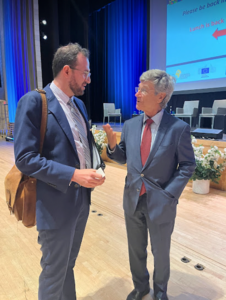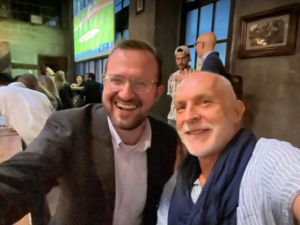New York City was busier than usual last week.
The occasion was Climate Week, a host of events devoted to charting and increasing environmental progress. Hundreds of sold-out summits, covering everything from biodiversity to energy, could be found across the metropolis. And within those halls, would-be thought leaders discussed the challenges of sustainability with both earnestness and self-congratulation.
There was a tension, however, at the heart of Climate Week. At the collective podium, most of the assembled businesspeople, policymakers, and civil society representatives argued that GDP growth was compatible with—indeed, necessary for—environmental sustainability. In the hallways, however, the desirability and viability of growth was challenged as never before.
Climate Week thus provided an opportunity to gauge how steady staters can engage strategically with different actors in the contemporary environmental movement. Boiled down, these engagements can take three forms: 1) increasing demand for steady-state reforms among those involved in parallel initiatives, 2) building further alignment of groups currently involved in elements of steady-state reforms, or 3) increasing the capacity of groups involved in systematic steady-state reforms.
Green Growth at the Dais
The first thing to note about Climate Week, however, is that economic growth is still trumpeted as the solution to Earth’s environmental woes within most “official” forums. This was nowhere better displayed than at the 11th Annual International Conference on Sustainable Development, a Climate Week side event I attended at Columbia University.
The assumption here, of course, was that GDP growth would lead to the goals—economic development, SDGs, and the like—that policymakers in the United Nations and the Global South sought. And there did seem to be a rough correlation between GDP growth and some valuable social metrics in the Global South, such as increases in lifespan and education. But GDP growth is not the only way of increasing these metrics, as we know. And there was no discussion of how GDP growth might come at the expense of sustainable development goals, except through the deus-ex-machina of decoupling.

The author discussing the merits of the steady state economy with Jeffrey Sachs. (Daniel Wortel-London)
Outside the auditorium, however, I discerned several notes of heresy against the “green growth” agenda. One developer of the original SDGs confided in me that he had “sympathy” for the notion that GDP growth and environmental sustainability were not compatible. (He even signed the CASSE position on economic growth.) Another attendee, the program director of “Net Zero and Sustainability” at a major university, agreed that GDP growth undermined environmental health. When I asked her how this shaped her decision-making as a program director, however, she said that it largely wasn’t relevant. Tellingly, she did not bring up her point about GDP in her subsequent panel discussion at the conference.
I also saw that the ranks of “green growth” advocates were less solid than I had believed. When I asked several conference attendees whether they thought the SDGs could be met while still growing the GDP, most individuals said “yes”—until I asked whether they could be delivered according to schedule. Most hesitated at this point and sheepishly admitted that GDP growth would have to decline—at least in the short run—if the SDGs are to be met within the timeframe established by the UN.
There are several strategic takeaways here. First, it appears there is unexpectedly deep support for the steady-state position among many policymakers—but these same policymakers fear expressing this support too vocally or publicly. This is a cause for optimism, however: Once the steady-state position becomes more viable, we should see more support among these “late adopters” come relatively quickly. In the meantime, we should be having frequent confidential, non-committal, and one-on-one conversations with strategically placed policymakers in order to sow the seeds for this later support.
Second, there is an opportunity to build demand for a steady state economy among policymakers by pointing out how growth can undermine their other goals. Most individuals I spoke to believed growth and sustainability were reconcilable “in theory”—but expressed doubts about their reconcilability “in practice,” particularly in relation to hard deadlines and targets. I took away from this that while many policymakers optimistically believe we can “do both”—achieve economic growth and sustainability together—they become more sober when confronted with evidence that “doing both” won’t occur fast enough to meet goals they themselves have set.
On these grounds, we can counter the virtue of optimism with the virtue of pragmatism. By showing the failures of growth, we can create a demand for solutions that solve the same problems “green growth” is meant to address. To do this, we need to present a simple, positive, and credible vision of what a steady state economy can actually deliver, both socially and environmentally. In short, by linking the goals of different groups with the outcomes of a steady state economy, we can create a broader demand for this economy.
Building Alignment
There was also something to be learned from the enormous climate protests taking place alongside Climate Week.
Many of these protests converged on a single ambitious and specific demand: to “end fossil fuels.” There is enormous tactical value to this specificity. It names a specific problem (climate change), puts pressure on specific actors (the fossil fuel industry), and raises specific measures to address the problem (ending fossil fuel subsidies and disinvestment from fossil fuel corporations, to name two). It is a goal broad enough to attract many different coalition partners but focused enough to build momentum around a manageable level of policy redress. That is why groups ranging from environmental organizations to indigenous justice organizations to labor unions took part in these protests.
There is much that the steady-state movement can learn from this. It isn’t enough to call for “ending growth.” We need to talk about how this growth is going to be ended among a wide range of actors (and point out how they will benefit thereby). Policy reforms are a good start.

How can we align the steady-state cause with the concerns of young climate activists? (Ivan Radic/Creative Commons)
Nonetheless, carbon emissions are only one of the planetary boundaries that are being breached, and fossil fuel expansion is a symptom rather than a driver of the problem. If we are to place blame where blame is due, it is on economic growth itself (and/or the people and organizations that push for it). And while eliminating fossil fuels might slow economic growth as a by-product, it is no substitute for a full-court press on all the actors promoting all forms of economic growth.
But how to do this? The Movement Lead of the Wellbeing Economy Alliance (WEALL) made a salient point. We needed to find actors who could build alignments between the interest of groups “inside the room”—the businesspeople and policymakers in Climate Week auditoriums—with the activists “outside the room.” Identifying these actors will require networking across silos and a willingness to compromise. But as WEALL likes to say, “togetherness is more important than agreement.”
The collection of individuals at this informal event bore out WEALL’s statement. A campaign manager for the Club of Rome-sponsored Earth4All movement, the chief innovation officer from the Solutions Journalism Network, a well-known social media personality focused on climate issues—all were at our table, and all of them signed the CASSE position on economic growth. We may have had profound disagreements on some issues, but we were all aligned on the question of degrowth toward a steady state economy.
But we hadn’t aligned by accident. It had taken years of proactive outreach, network building, and sensitive relationship management to get to this point. But we had reached it, together.
Increasing Capacity
The final strategic takeaway from Climate Week was the need to increase the capacity of groups aligned with our mission: groups like the Wellbeing Economy Alliance, Earth4All, organizations in the degrowth movement, and others. It was clear from my conversations that none of us, individually or collectively, currently have the resources to take on advocates of green growth. But the point of strategy is to use “what we have” to get “what we want.” So what do steady staters have, and how can we use it to build our collective strength?
To figure this out, we need to map the individual skills, knowledge, resources, and connections that steady staters have, starting with CASSE and its members, signatories, and endorsing organizations. We can then identify how our unique assets can be best leveraged within the current field of environmental reform organizations. And by providing this support, we can start building the goodwill that can get us alignment—and resources—from other organizations.

The author with the Wellbeing Economy Alliance’s Simon Ticehurst (Daniel Wortel-London)
Accomplishing this “asset mapping” would be relatively simple. It’s a matter of surveying steady staters on the most valuable tangible and intangible resources they have, and strategizing on how those resources could best advance the steady-state mission. For example, do any steady staters know any prominent foundation officers? These connections can form the basis of joint fundraising between CASSE and other relevant organizations. Do any steady staters have a strong background in economics? This valuable skill can be leveraged on behalf of providing an evidentiary base for our allies’ policy documents.
Indeed, based on my experiences at Climate Week and elsewhere, it seems that there are very few organizations working on policy design in any way adjacent to a steady state economy. If steady staters were to act as the chief “translators” of ecological economics into policy, they would be able to gain a wide audience among policymakers, economists, and ecologists alike. Not a bad niche to be in.
Preparing for Next Time
Climate Week NYC, of course, is only one of many environmental summits taking place this year. COP 28, in November and December in Dubai, offers another opportunity to present the steady-state cause to the world (hopefully it will have less-mixed results than last year’s COP 15). To take advantage of this opportunity, however, will require preparation on how we can best increase the demand for and capacity of the steady state economy movement.
Now’s the time. As Goethe wrote,
Whatever you can do, or dream you can—begin it;
Boldness has genius, power, magic in it.





